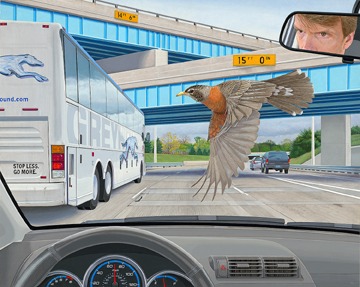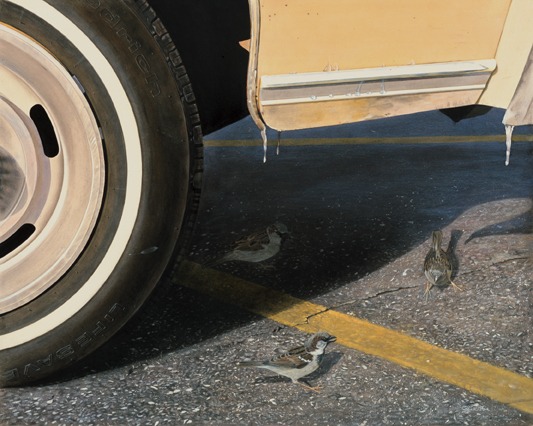Creating awareness may be the best way art and artists can promote stewardship of the earth. Art can help people notice something they previously failed to see, or only had a cursory interest in. The urge to create can be strong.
The societies have long valued art and creativity. For example the cave art of Lascaux and Altamira in Europe. These were done by people who lived day to day, but some of them were driven to create art. Attuned to the natural world around them, and inspired to document it, but the purpose of this creative output is unknown.
My work can be described as an obsession with the details. I am interested in the surface textures and creating paintings that portray them in realistic detail. Hopefully a viewer will feel they can run a hand over the feathers and moss, or grasp an object in the painting. The design can occur naturally or be arranged by me. The major themes of my work are usually based on patterns and texture of nature, and the human interaction with nature. I have found subjects to paint in remote wilderness areas of the world, local parking lots, and my own backyard. Jean-Auguste-Dominique Ingres, Robert Bateman, J. F. Landsdowne, photorealism, and impressionism influence my work.
Some subjects of my work are often considered common and over-looked (insects, frogs, etc.). These are portrayed in their natural environment. Focusing on the intricate details that can be taken for granted. Many of the “common” species I depict in my art are declining in population. The U.S. Geological Survey study “Trends in Amphibian Occupancy in the United States” documents how amphibians are disappearing. The exact reasons for the decline in amphibians are not clear. Scientists believe several factors, including disease, invasive species, climate change and pesticide use are contributing. Honeybees and other insect numbers are also dropping. I hope my work spot lights these vanishing species bringing recognition of their plight.
Human interaction with nature is the other ongoing theme of my work. Modern life often involves technology. Occasionally people get very involved with their technology and miss what’s happening around them. Some people see humor, some see danger in my work. I set the scene and let the viewer interpret it. The two paintings in Environmental Impact are typical of my human nature interaction themed work. The two urban scenarios represent birds surviving (maybe) in our motorized world. Events like these might be one of the few times some people notice the natural world.

Rick Pas Robin Overpass 2009, Acrylic on Panel, 27×33 © Rick Pas. Previously on display in Environmental Impact
Birds flying in front of or near vehicles is a reoccurring subject for me. The painting Robin Overpass is part of that series. It depicts a robin dramatically appearing in front of the windshield of a motorist on an expressway. A split second in time. Is the driver about to react, does he care? Does the bird survive?
In Parking Lot Sparrows, house sparrows are scraping out a living in a parking lot. Flitting and hopping around seeking food and shelter. They are adapting to an environment we produce.
Many artists donate work to conservation causes to be used for fundraising, and do volunteer work. Some even start their own organizations dedicated to conservation and the environment. On a more selfish note, nature is one of my favorite subjects to explore. Artistically and in person. I am a consumer. I use plastic paint, electric lights, drive a car, fly in planes, heat my home with propane, the list goes on. I can’t preach, but can try to moderate and make educated choices.
It’s an honor to be in the Environmental Impact exhibition. The 2D and 3D pieces included in the show range from forbidding and depressing to serene and hopeful. I found it strange that many of the pieces that are disturbing in the portrayal of environmental destruction are also visually appealing in their execution. People may come away from the exhibit pessimistic or optimistic, but aware.
The works by Rick Pas featured above were on display in the traveling museum exhibition Environmental Impact, which closed at St. Mary’s College on May 1, 2016. A sequel is scheduled for January 5 to May 26, 2019 at the North Carolina Arboretum in Ashville, NC.
 Rick Pas is a contemporary realist who finds artistic inspiration in nature.
Rick Pas is a contemporary realist who finds artistic inspiration in nature.
He has a BFA from Eastern Michigan University, among his awards are an Arts for the Parks Regional Award, two Michigan United Conservation Clubs’ Wildlife Artist of the Year, and the Indiana Migratory Bird Stamp design. National and regional publications where his art has appeared include The Artist’s Magazine, Audubon, Southwest Art, and American Art Collector. His paintings feature intricate details uniquely composed in abtract designs. Influenced by Ingres, O’Keefe, Bateman, Lansdowne, photorealism and impressionism.
Rick has exhibited at the Fort Lauderdale Museum af Art, Anchorage Fine Arts Museum, Flint Institute of Art, and the Field Museum of Natural History in Chicago.
His work can be found in collections across North America, including Ameritech and General Motors Corporation in Detroit, MI, and the Leigh Yawkey Woodson Art Museum in Wausau, WI.
This post is part of the MAHB’s Arts Community space –an open space for MAHB members to share, discuss, and connect with artwork processes and products pushing for change. Please visit the MAHB Arts Community to share and reflect on how art can promote critical changes in behavior and systems and contact Erika with any questions or suggestions you have regarding the new space.
MAHB-UTS Blogs are a joint venture between the University of Technology Sydney and the Millennium Alliance for Humanity and the Biosphere. Questions should be directed to joan@mahbonline.org
MAHB Blog: https://mahb.stanford.edu/blog/details-of-common-overlooked/
The views and opinions expressed through the MAHB Website are those of the contributing authors and do not necessarily reflect an official position of the MAHB. The MAHB aims to share a range of perspectives and welcomes the discussions that they prompt.
